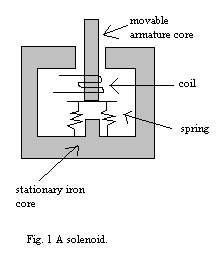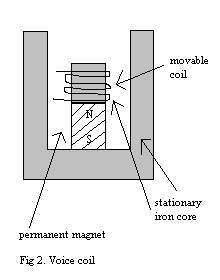Difference between revisions of "Solenoid Theory"
m |
|||
| Line 21: | Line 21: | ||
<br clear="all"> |
<br clear="all"> |
||
==References== |
|||
*Histand, Alciatore, "Introduction to Mechatronics and Measurement Systems," McGraw-Hill, 1999 |
|||
Latest revision as of 16:47, 5 July 2006
Overview
A solenoid is simply a specially designed electromagnet. A solenoid usually consists of a coil and a movable iron core called the armature. Here's how it works.When current flows through a wire, a magnetic field is set up around the wire.If we make a coil of many turns of wire, this magnetic field becomes many times stronger, flowing around the coil and through its center in a doughnut shape. When the coil of the solenoid is energized with current, the core moves to increase the flux linkage by closing the air gap between the cores. The movable core is usally spring-loaded to allow the core to retract when the current is switched off. The force generated is approximately proportional to the square of the current and inversely proportional to the square of the length of the air gap.
Solenoids are inexpensive, and their use is primarily limited to on-off applications such as latching, locking, and triggering. They are frequently used in home appliances (e.g. washing machine valves), office equipment (e.g. copy machines), automobiles (e.g. door latches and the starter solenoid), pinball mahines (e.g., plungers and bumpers), and factory automation.
Applications
An electromechanical relay is a solenoid used to make or break mechanical contact between electrical leads. A small voltage input to the solenoid controls a potentially large current through the relay contacts. Applications include power switches and electromechanical control elements. A relay performs a function similar to a power transistor but has the capability to switch extremely large currents if necessary. However, transistors have a much shorter switching time than relays.
As illustrated in figure 2, a voice coil consists of a coil that moves in a magnetic field produced by a permanent magnet and intensified by an iron core. The force on the coil is directly proportional to the current in the coil. The coil is usually attached to a movable load such as the diaphragm of an audio speaker, the spool of a hydraulic proportional valve, or the read-write head of a computer disk drive. The linear response and bidirectional capability make voice coils more attractive than solenouds for control applications.
References
- Histand, Alciatore, "Introduction to Mechatronics and Measurement Systems," McGraw-Hill, 1999

